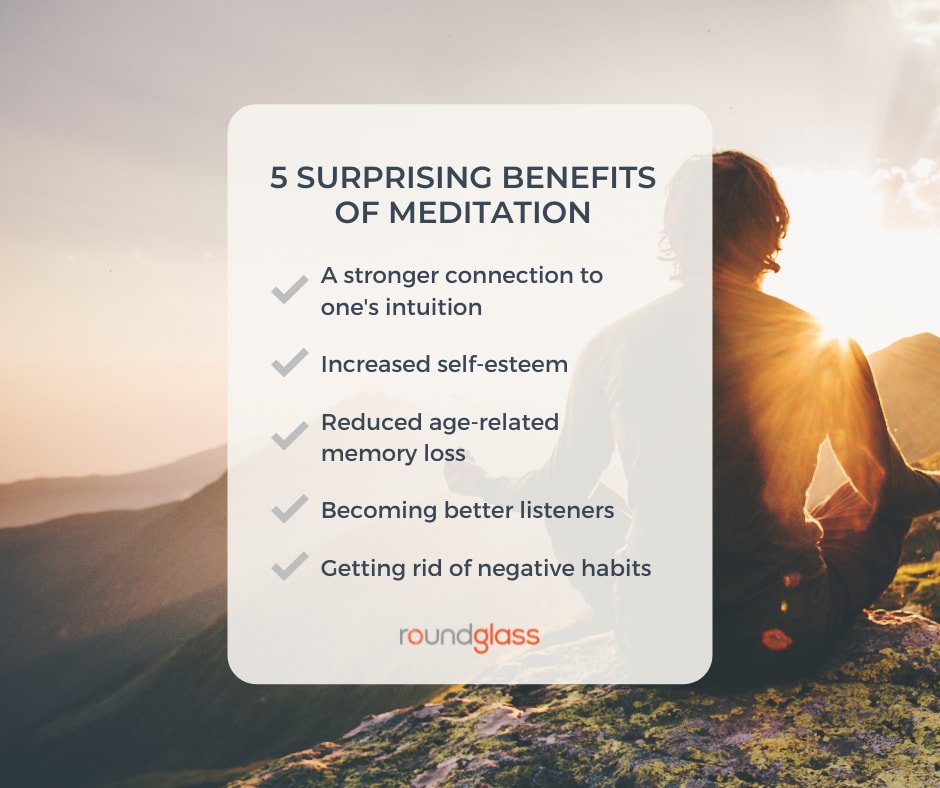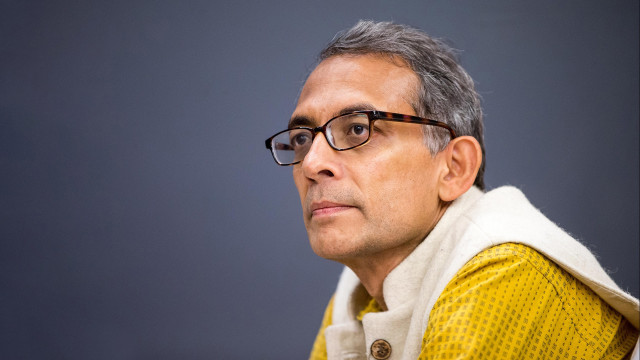Why You Need to Start Meditating

Eating fresh fruits and vegetables; breaking a sweat several times a week; sleeping close to eight hours every night … No one could deny that these healthy habits help us feel strong, energized, balanced, and even happy. But what if they all paled in comparison to one simple practice that could take your wellbeing journey to the next level? We're talking about meditation, a practice that may do this and much more.
To truly tap into your full potential as a human being you’ll have to go further than focusing on the physical body. The importance of meditation, and the reason why it’s a gamechanger, lies in the fact that it focuses on the most important part of you: what’s on the inside. With consistent practice, our brain changes and so does our body chemistry. As a result, the way we look at the world and how we relate to it and experience it also changes. Meditation can be seen as a superpower, as it can help us get closer to the person we want to be, and it makes life better in almost every way.
What Is Meditation?
Meditation is something we do intentionally to increase our presence and awareness. It can also provide a blossoming array of physical, mental, and emotional benefits. Creating such a shift in our minds and inner landscape requires specific techniques; and there’s a style for everyone.
These styles vary vastly from one another and have a variety of approaches, goals, and benefits. Some improve your focus and attention span, many of them help you relax and stave off stress, others improve your immunity or increase your self-esteem, and the list of positive effects goes on. Putting all of these practices under one umbrella is not a simple task, but we could loosely say that meditation is a mental exercise that we practice to change — and ideally improve — our state of mind, or to have heightened spiritual experiences; and as a result, to improve our day-to day lives.
Here’s a short list of some of the most popular meditation styles:
Mindfulness meditation: The Harvard Gazette describes this style of meditation as one that “teaches you the skill of paying attention to the present by noticing when your mind wonders off.” This attention to the present moment can be achieved by observing the breath, any physical sensations, or whatever is happening in the moment.
"For me, mindfulness is the most accessible style of meditation. It allows me to integrate it as a lifestyle and not just as something that I practice separate from my everyday activities."
Curtis Smith is a mindfulness teacher, as well as a motivational speaker and educator based in L.A.
Vipassana or ‘insight’ meditation: This meditation style fine-tunes our awareness so we can learn to see things as they really are. This is most commonly achieved by observing the sensations in the body with complete neutrality — so we can realize that nothing is intrinsically good or bad, and we can see life with fresh and unburdened eyes. As a result, our pre-conceived ideas and judgements of the world and of ourselves fade away, allowing for greater self-acceptance, self-confidence and satisfaction with life, among many other benefits.
"With each sit, I come to know myself and the larger world more intimately and in an interconnected way. It allows me to not have to be anyone. The face I show the world melts away."
Kate Savage is an artist and Vipassana meditation teacher based in Eugene, Oregon. She is drawn to this ancient Buddhist meditation tradition for many reasons — among them, the freedom she gets from the usual way of looking at things.
Loving-kindness meditation: This type of meditation, also known as metta meditation, helps you cultivate a state of friendliness and compassion towards others. A 2008 study found that this practice can increase positive emotions such as hope, pride, gratitude and contentment. It can also help the practitioner experience an increased sense of purpose and stronger social connections.
Kundalini yoga: This style of yoga integrates a lot of breathwork and meditative practices into it; so even though it’s known as a yoga style, we could also consider it a kind of meditation. The nonprofit 3HO describes Kundalini yoga as “a holistic technology” where “the primary focus is on the movement and transformation of energy.”
"I love knowing what I’m specifically working on. It feels proactive, healing and supportive. I can support whatever process or stage of life I’m going through with the extensive range of meditations available in Kundalini yoga."
Patwant Rhodes has been practicing and teaching Kundalini yoga in South Africa for decades. She became enamored with this practice because of many options it gave her to deal with different moments and situations in her life.
Mantra meditation: Mantra is a spiritual word or phrase (usually in Sanskrit), that can be repeated either silently and effortlessly, as the Transcendental meditation technique teaches; or it can be repeated out loud or ‘chanted.’ The effect varies depending on the mantra chosen and the approach used.
"I enjoy mantra meditation because you can chant the mantras while going about your day-to-day life. There’s no need to carve out time for it. Yes, it’s definitely better to sit still when you chant, but even if sometimes you can't, you don't have to skip it altogether."
Sowmya Raoh, who teaches the Roundglass course on the power of mantra meditation, believes that finding a practice that can blend easily into our daily life is the way to go.
Guided visualizations: This style is a great introduction into the meditation world. The teacher guides you through the whole process, so all you need to do is follow the instructions; instead of being your own director worried about keeping focus. There are guided meditations and visualizations for everything under the sun — from achieving deep states of relaxation, to healing your body and aligning the chakras or energy centers.
With so many options to choose from, you should pick the style that best fits your personality and preferences.
"I try to find the technique that's right for the moment, so I've had a voracious appetite to learn different styles. It is my view that every meditation session offers you a chance to make an intentional choice. Find the approach that's right for this moment, for this week, for this chapter of your life, and do that."
Jay Vidyarthi, a tech designer and mindfulness teacher based in Canada, strongly believes that when it comes to meditation, variety is key for optimal results.
So don't be shy when it comes to trying out different teachers and techniques, until you find one — or several — that really speak to you. Find your spark in the style that motivates you to keep a regular meditation practice and take it from there.
Reasons to Meditate
Meditation is a great life resource because it’s accessible, anyone can do it, it doesn’t require any special clothing or equipment, and only a few minutes of practice per day can provide significant long-term benefits.
Knowing what these benefits are will hopefully give you the motivation needed to get started and to keep going. Some well-researched effects of meditation include:
- Reduced stress, depression, chronic pain and anxiety
- Decreased rumination and emotional reactivity
- Increased wellbeing
- Improved sleep
- Stronger immunity
- Decreased blood pressure
- Heightened attention
- Increased emotional regulation and empathy
- Improved communication
- Optimized performance at work
- Decreased test-stress for students
On top of these well-known effects of having a regular meditation practice, if you talk to a group of seasoned meditators, the list of benefits will expand exponentially.

How to Start Meditating as a Beginner
Learning to meditate can really be quite simple, so don’t let trying something new intimidate you. All you need to get started is the desire to give it a try.
Find Your Meditation Style
The first thing you may want to decide is whether you want to learn to meditate in person with a teacher, or if you want to try out one of the many guided meditations, meditation courses available online. You can get positive results either way, as meditation is more about doing the practice and staying consistent with it, than how or where you do it.
Whatever setting you choose, it’s always best to start with a meditation technique for beginners. In today’s meditation-curious world, there are plenty of choices, such as our mindfulness meditation course for beginners, our course on Meditation Made Easy, or our 21-day jumpstart to a powerful meditation practice.
Be Patient, It’s a Process
Once you find the practice that suits you, don’t be discouraged if you don’t see results right away or if you find it difficult at first. With practice, meditation will help calm your mind — but it may first show you how unsettled your mind actually is. Feeling restless during your first few meditation sessions doesn’t mean that you’re doing it wrong or that the technique is not working. All it means is that you’re finally taking the time to slow down and observe the content of your mind. This is a good thing, and only the beginning of your meditation journey. If you stick to the practice, your meditation sessions will become deeper and increasingly more rewarding.
Make Time to Meditate
We cannot stress this enough: Put some time on your calendar to meditate. The No. 1 reason people fail at meditation is because they don’t make it a daily habit. Meditation works — plain and simple. But for it to work, you actually have to commit to the practice. So go ahead and block out time in your calendar, set an alarm clock, or cover your laptop with Post-its reminding you to do it. Whatever it takes to get you meditating every day, do it. It will be worth it.
As you can see, if meditation is not part of your daily life yet, you are missing a key component of a life of true wholistic wellbeing. Feeling great is a two-way street — we need to take care of the outside, and also the inside. Body, mind, and soul have to be in balance, in order for us to experience true wellbeing and thrive. There’s a whole world of meditation out there waiting for you, and our hope is that you explore it, have fun with it, and then savor the many, many benefits you will get from it.
Key Takeaways:
- Meditation is something we do intentionally to increase our presence and awareness.
- A regular meditation practice can result in a number of health benefits like improved sleep, increased focus, emotional regulation and more.
- Find your meditation style by trying a guided practice. Then stick to a routine to reap the benefits.
- Put some time on your calendar to meditate. Turn it into a daily healthy habit.








